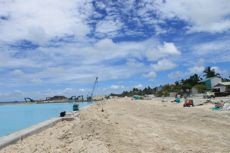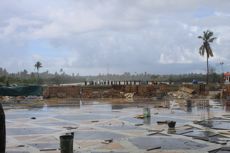A group of Royal Air Force (RAF) veterans remember their time on the beautiful Maldivian island of Gan in the Addu Atoll as the best days of their lives.
Living thousands of miles from home, the servicemen of Coral Command who lived and worked on the atoll of Addu in RAF Gan and nearby Hithadhoo, where the RAF were fitting radio transmitters in the seventies, made their own fun long before the resorts were created.
In true forces style the squadrons based here, mainly Brits and the Indian Air Force, with a couple of Americans, created a night life scene which was enjoyed by many, including some liberal locals. Sadly, all this ended when the forces pulled out.
The RAF needed to travel back and forth between the islands for work and entertainment. They built a causeway linking six islands to help them to get there easily but before that they had to travel by boat.
Nowadays there is little entertainment, save the bar at the Equator Village resort in Gan on the other side of the island, and the sleepy hamlet of Hithadhoo is a very different place now – but it didn’t used to be, as one former airman reveals.
Richard Houlston, now 63, remembers the recreational activities which were available in the seventies in Hithadhoo after hours. Long before the resorts, Hithadhoo can proudly boast the establishment of the first entertainment in the Maldives.
Weekends were filled with diving and crab fishing, dhoni racing, pranks and skinny dipping in the pristine lagoon. After work hours Coral Command would spend hours drinking at “Siggies bar”, known affectionately as ‘Fairly Blato’, for obvious reasons.
On special occasions, some of the lads would head to the legendary Bushy disco – the first outdoor rave on a jungle-cropped island close to Hithadhoo.
“There were around 25 of us on the site when I arrived, this gradually increased to about 50 over the next few months when Skynet came (Satellite Communications),” remembers Richard.
“We had a big 2000 litre water tank in case of fire but we filled it full of fish from the lagoon, including three 4ft sharks, six puffer fish and a large titan trigger who ruled the pool. This had to be emptied, cleaned out and re-filled every week on a Tuesday afternoon to keep it going.
It was very entertaining to watch the catching of a four foot long shark by the tail,” Richard recalls.
Many hours were enjoyed placing a pole across this tank for people to walk across (which gives a whole new meaning to Shark Infested Custard, for those with a service background).
“No one ever did manage to make it across. If they looked as if they were doing well the pole was rolled first one way then the other! With three 4ft sharks in there, no one stayed in long,” he laughed.
On weekends and evenings many pranks were played by the men on their fellow comrades. These practical jokes helped to keep camaraderie and spirits high and playful by nature Richard was one of the main pranksters.
“John Scott and I used to go and catch 20 sand crabs and a large land crab every evening after tea and sometimes at night when everyone was in the bar Scotty and I would catch frogs and put them in peoples beds. We’d put the land crabs in washing boxes or down the loo,” he said.
“It was quite startling when you are about to seat yourself down to have a number two and a huge pair of pincers suddenly appears – that would make your eyes water.”
Firm and long lasting friendships were made during the time on Addu, which is evident in the hundreds of messages posted on the Then and Now website.
These lasting friendships enabled the RAF Gan memorial visit a couple of years back, where more than 50 former airmen and officers stepped back onto the atoll and met again for the first time in almost 40 years.
Many shared tales of times gone by and made new friends too. At the time men were not allowed to socialise with local women so with little social interaction, apart from with each other, the men filled their days with activities such as snorkelling, and diving.
There were dhoni competitions where men would row for entertainment and many other games too.
“As you are probably well aware the main problem with Gan was the lack of women. For 12 months with no female companionship, it was very difficult for servicemen – almost unbearable,” Richard explained. “Of course, we were not allowed to meet the Maldivian women, probably just as well, as I think I might still have been out there… or washed up on some beach.”
He left the air force to get married and remains happily so, with two children and recently the addition of a new grandchild.
There were some characters on the base. Richard fondly recalls the madcap adventures and avoidance tactics of a particular infamous squadron leader called Buckle.
“At the time we had Squadron Leader Buckle based on Gan but in charge of us on Hithadhoo. He heard a rumour that some airmen on Hithadhoo were sunbathing in the nude. This would of course be upsetting to the Maldivians – well the men anyway – who used to pass through the camp from time to time.
“He made many surprise trips trying to catch the culprits but as they had to have permission to land the boat we always knew in advance,” he laughed.
“It sort of backfired on him when he had a little rhyme composed about him: ‘Bare Bum Buckle was his name’ and ‘Bare Bum Spotting was his game’. I can’t remember the rest, perhaps it just as well). I know we had a flag pole over the bar in the Hermitage with a belt buckle hanging from it – a hangman’s noose.”
The Hithadhoo Diary’ was a cartoon feature for each period and the last six months-worth can be read on the Gan Remembered web site.
While he wouldn’t admit it some of Richard and his colleagues’ pranks even made the gossip sheet, which covered part of the time he was there, he laughs.
Richard and his comrades from Coral Command re-visit Gan as much as they can still have a close connection to Gan and Hithadhoo through Facebook, some say their hearts actually never left the curiously heart-shaped atoll.
Visit the RAF Gan Memorial Website.

